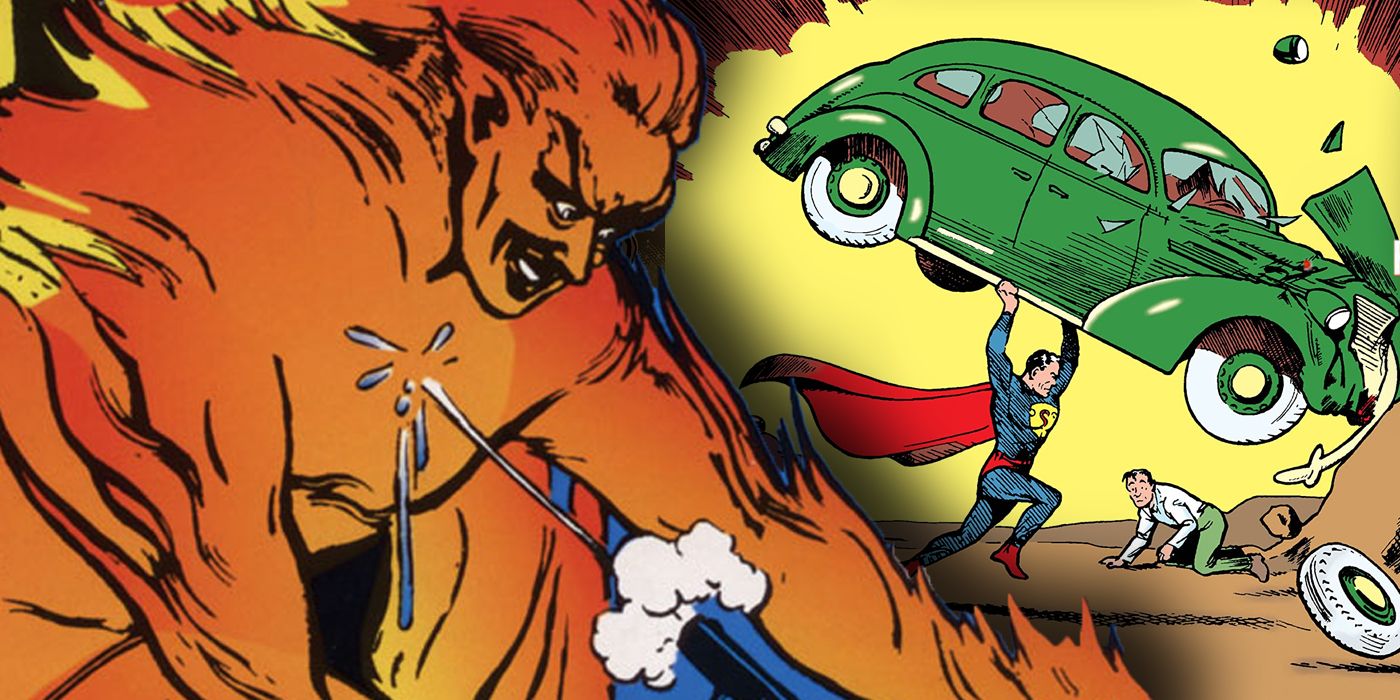
Today, we examine the first superheroes to fit a number of notable archetypes of superheroes, like the first super strong superhero, the first magician superhero, the first superhero speedster, the first superhero archer, etc.
In "When We First Met", we spotlight the various characters, phrases, objects or events that eventually became notable parts of comic lore, like the first time someone said, "Avengers Assemble!" or the first appearance of Batman's giant penny or the first appearance of Alfred Pennyworth or the first time Spider-Man's face was shown half-Spidey/half-Peter. Stuff like that.
A reader recently asked me who was the first superhero archer. I don't recall who made the suggestion, so feel free to write to me if you would like credit. In any event, I was poised to answer that one when I thought, "Why not just do all of the superhero archetypes?" So here we go.
This is an odd one, because really what I'm saying is "first comic book superhero period," but the point is that until Superman debuted, characters who wore masks and fought crime without superpowers really weren't SUPERHEROES, right? They were "just" masked vigilantes. No different than radio stars like the Green Hornet or the Lone Ranger or the Shadow. It's only once we've established the concept of superheroes that we would retroactively consider these masked vigilantes to be superheroes. However, at the same time, obviously, they ARE superheroes, as Batman is clearly a superhero, right? And Batman is essentially a Shadow riff. As were most of the initial masked vigilantes in comics, including the very first one, George Brenner's The Clock, who debuted in Funny Picture Stories #1 (by Comic Magazine Co.) in mid-1936...

It's worth noting that the Phantom had debuted as a comic strip before The Clock debuted as a comic book, but the Phantom didn't make it into comic books until 1940, so I think it's fair to credit the Clock as the first masked superhero. The issue, though, is one we'll see very soon, which is that it is kind of bizarre to credit a character as being the "first" of anything when they're clearly a riff on another established character (in this case, The Shadow). But the Shadow didn't debut in comics until later, so The Clock still gets the nod from me.
Remember what I said about how tricky it is to differentiate between "original" comic book characters and the clear influences on them? Never is that more evident than with the determination of who the first magician superhero in comics was. Lee Falk's Mandrake the Magician debuted in 1934 in comic strips and he was the clear influence on a number of characters, including Jerry Siegel and Joe Shuster's Doctor Occult, who debuted in 1935's New Fun Comics #5.
Occult began as a sort of generic private eye who specialized in the supernatural, but eventually became more and more of an ostentatious supernatural hero himself...
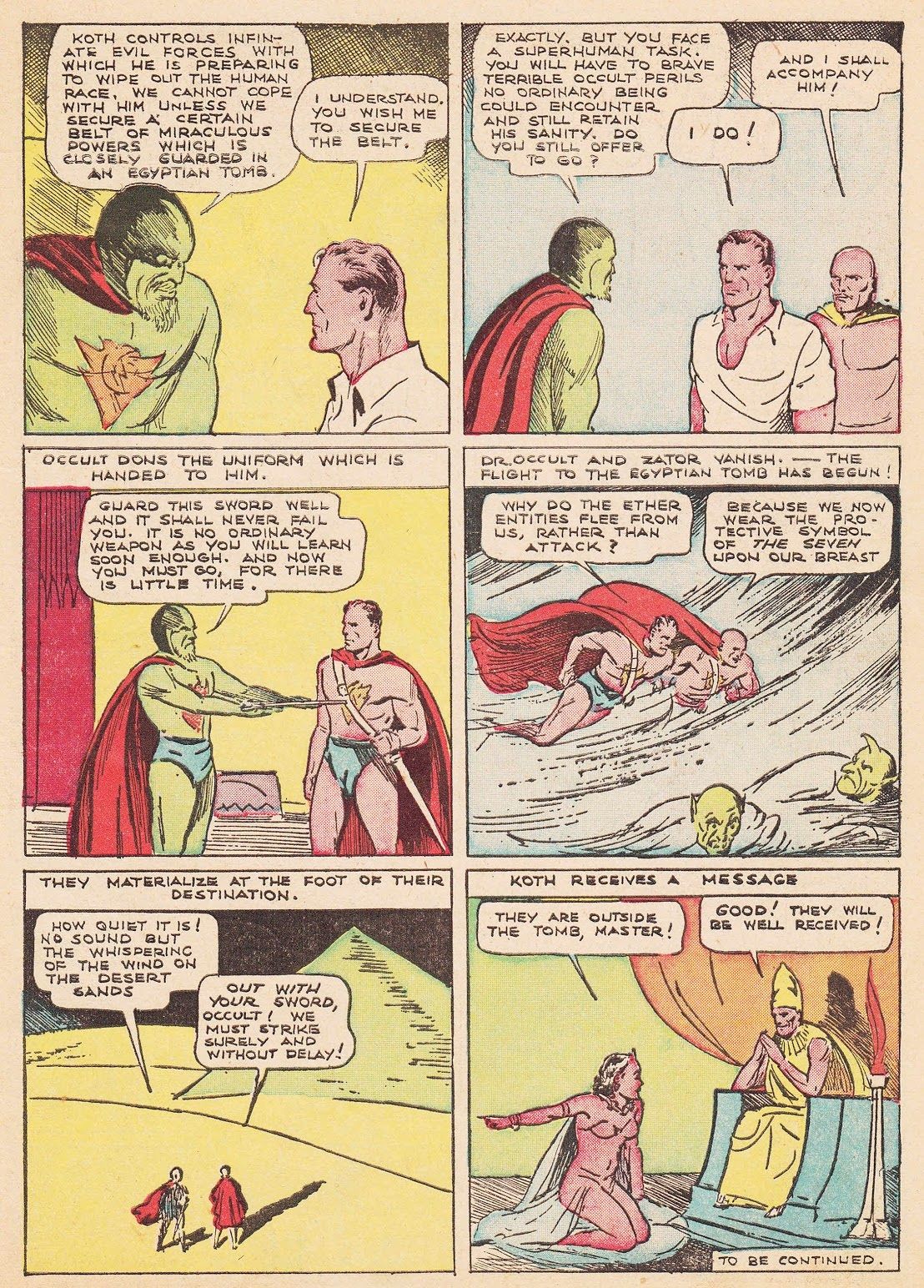
That sequence is from 1936's More Fun Comics #14 (New Fun was renamed More Fun). That predated Mandrake making his comic BOOK debut with reprints of his comic strips in King Comics. So while Mandrake is clearly the true archetype here, I guess Doctor Occult was technically the first COMIC BOOK magician superhero.
Here's one of the easy ones, as while yes, there were certainly super strong characters that appeared in comic books before Superman (the sheer variety of stories in the early days of comics pretty much guaranteed it), none of them were what you would call a "superhero." Not before Jerry Siegel and Joe Shuster's Superman in 1938's Action Comics #1...
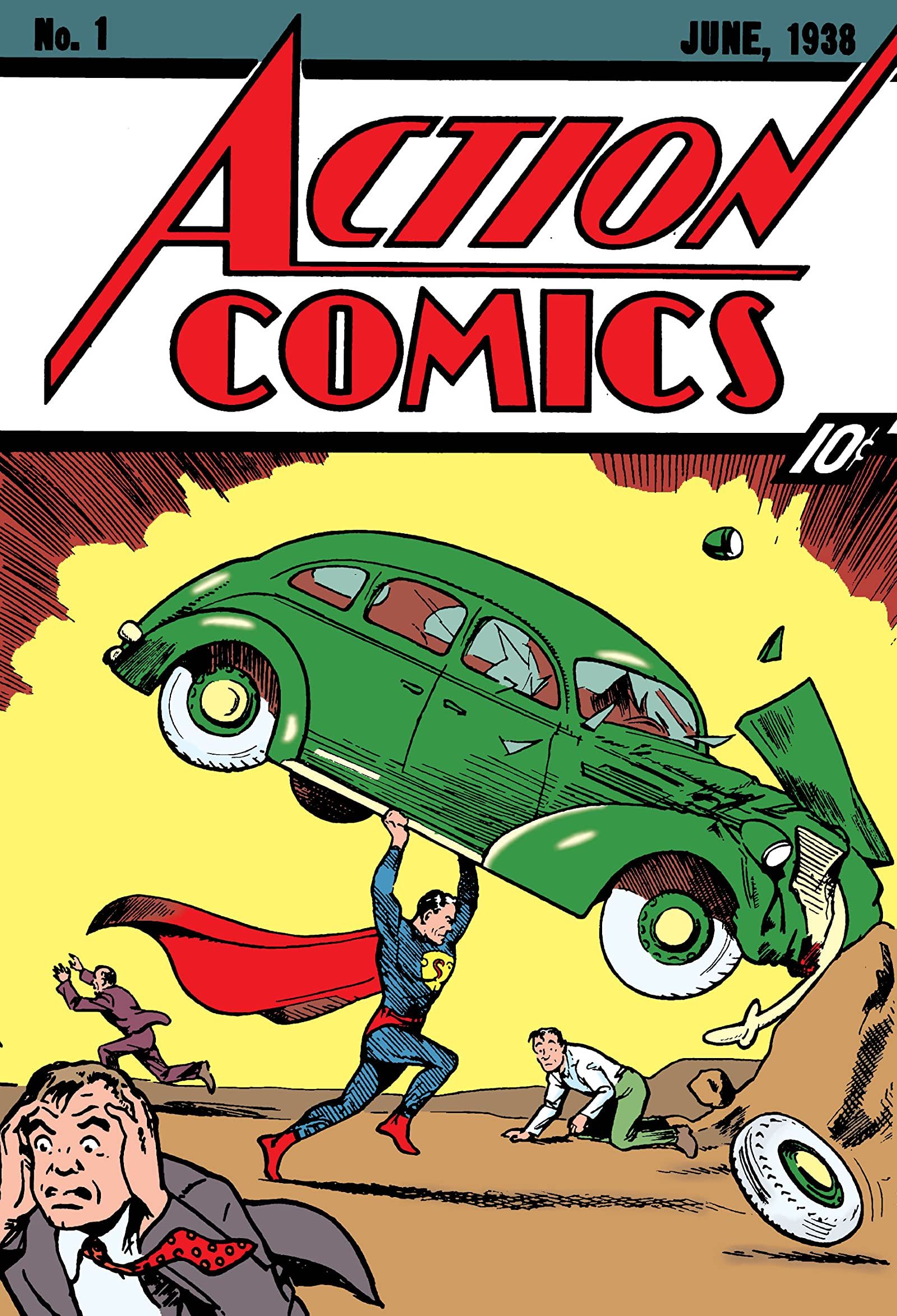
Siegel and Shuster obviously had earlier characters that influenced their creation (most famously, Philip Wylie's Gladiator, about a super strong very much like Superman, a book that Siegel later conceded in an unpublished auto-biography that it WAS an influence after years of denying it).
Another simple one! While, again, archers were common in comics (as archers are popular figures in pop literature, period), the first one who you would term a "superhero" was The Arrow, who was created by Paul Gustavson and debuted in 1938's Funny Pages #21 (stylized as Funny Pages Vol. 2 #10) for Centaur Publishing.
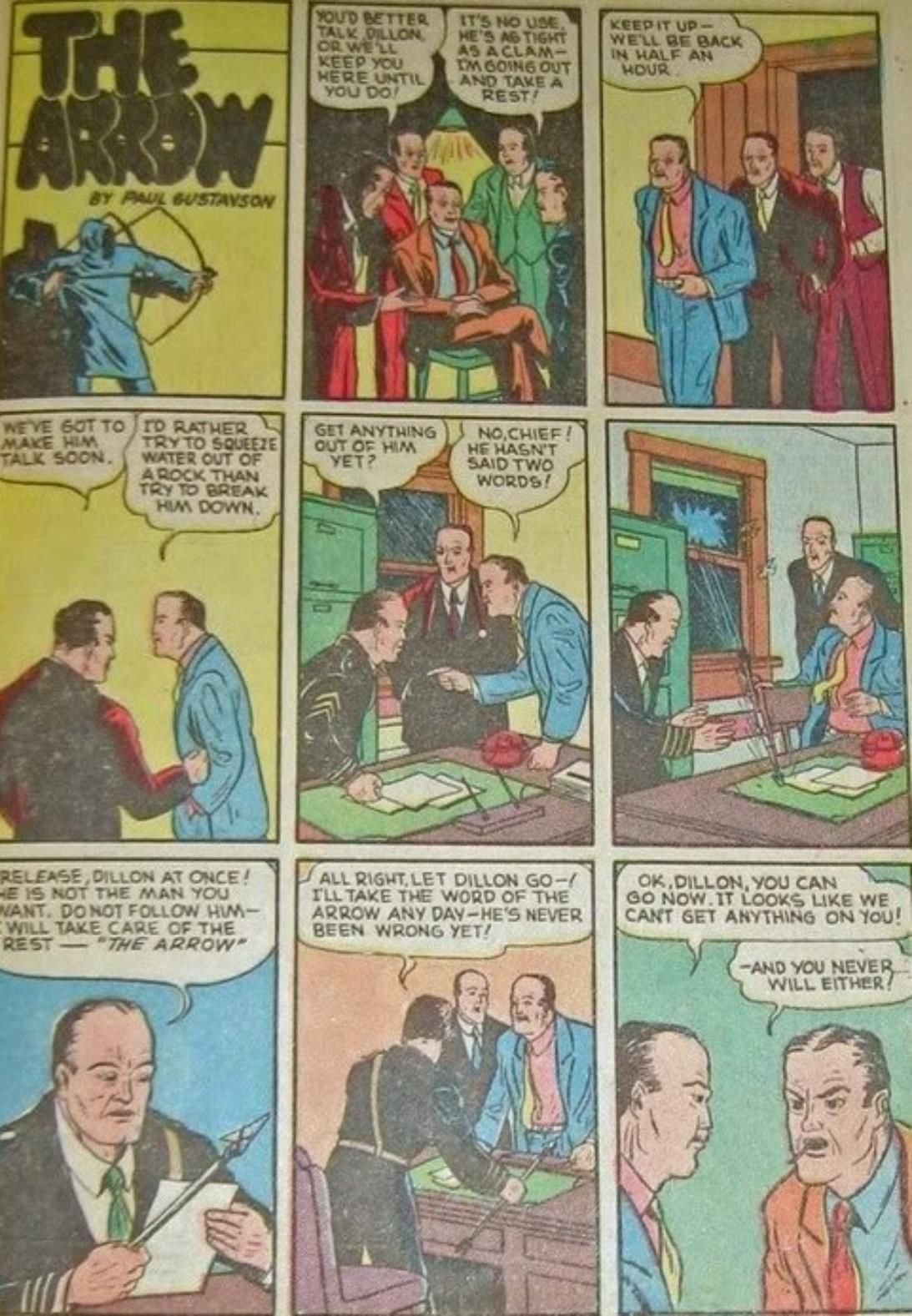
Just when it seemed like we were going to get back on track with simple ones, we get another tricky one. As you may or may not know, Namor the Sub-Mariner first appeared in a one-shot called Motion Pictures Funnies Weekly, designed to be used as a giveaway in movie theaters. Bill Everett wrote and drew the story but it was never published. He later expanded the story for 1939's Marvel Comics #1.
In the meantime, Louis Glanzman introduced the aquatic-themed superhero, The Shark, in Centaur Publishing's Amazing Man Comics #6, slightly earlier in 1939...
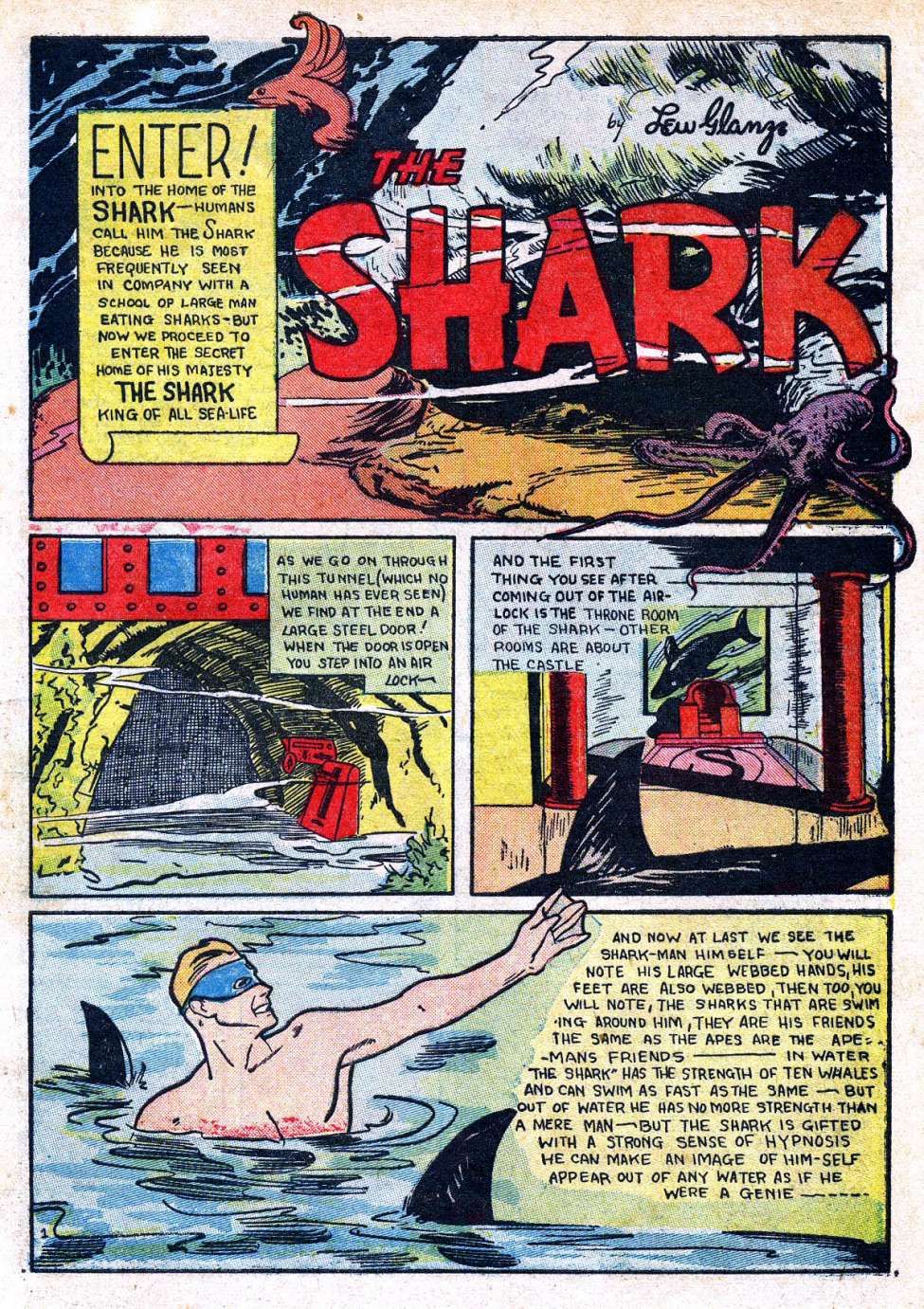
So The Shark beat Namor to the official publication date, but Namor WAS created first.
Even trickier is the first cyborg/robot superhero. At least here, the honor goes to Carl Burgos either way. In 1939's Amazing Man Comics #5 for Centaur Publishing, Burgos introduced the Iron Skull, who he eventually revealed was a cyborg. However, he didn't reveal that for some time. The early issues made it seem like perhaps it was just a special mask/helmet. Was he always intended to be a cyborg? Possibly, but because it was unclear, I'm going to go with Burgos' Human Torch in Timely's Marvel Comics #1 as the first cyborg/robot/android superhero...

Burgos clearly had a type.
Amusingly enough, the first flying superhero was possibly the first aquatic superhero, as Namor the Sub-Mariner was the first superhero to fly in Marvel Comics #1, but I can see the argument that he's just leaping in that issue (I don't agree with it, but I can see the argument), so let's instead go with Marvel Mystery Comics #2, Namor's second published appearance by Bill Everett, where he plainly flies...
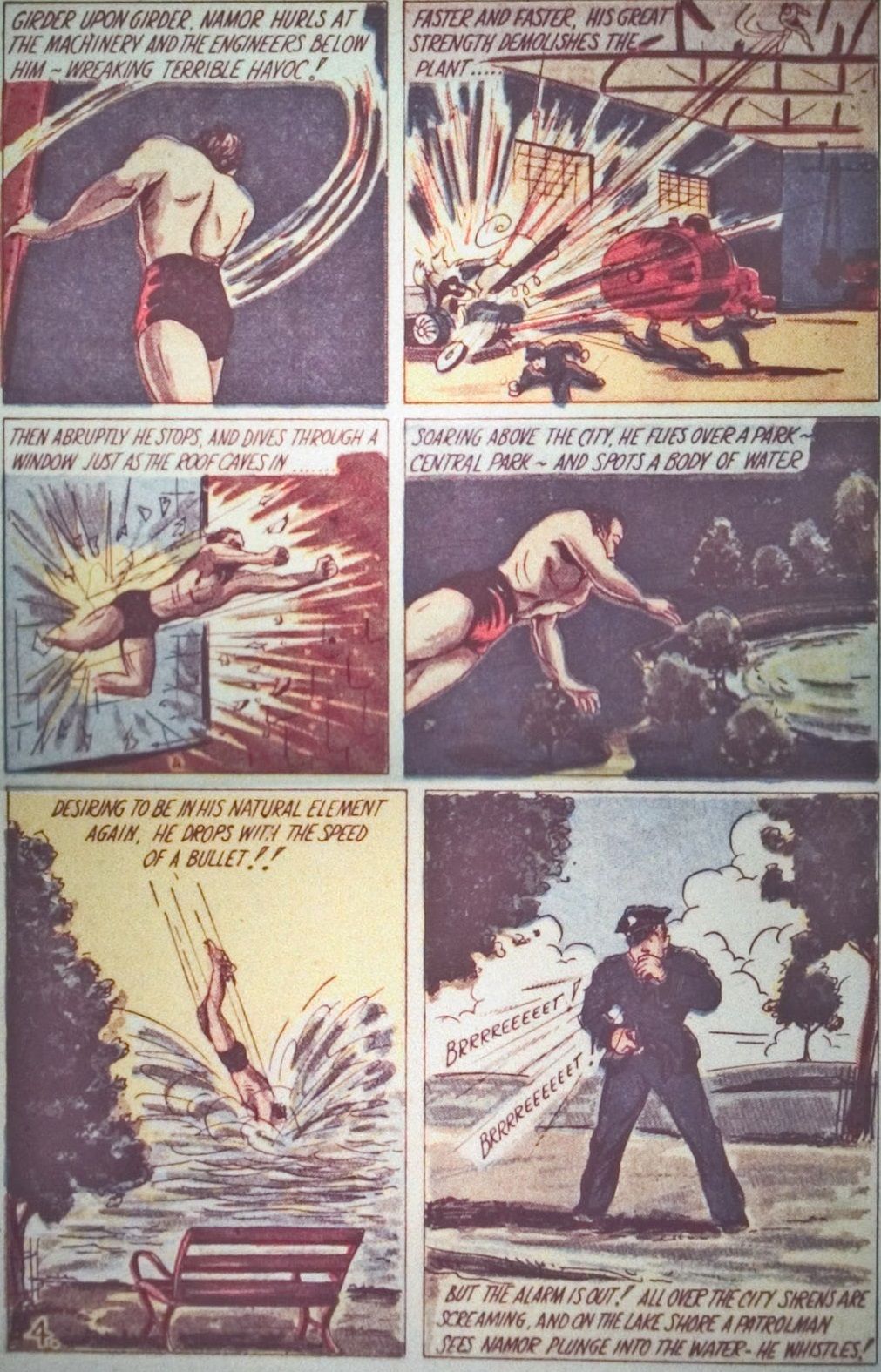
Other superheroes would start flying VERY soon after this, as it's simply a much better visual. And I don't think it was influenced by Namor, but rather just parallel thinking, as everyone came to the same conclusion around the same time.
This is another tricky one, because it comes down to what we think of when we think of energy projection. As noted, there were MANY magician superheroes in the early days of superhero comics, and a lot of them would often have some sort of spell that would involve energy projection, but not the way we think of it. You know, like blasting people with energy. Harvey Comics debuted Shock Gibson in Speed Comics #1, who LOOKS like he is going to blast people with electricity, but he instead just uses the electricity to create force fields around himself or to give himself strength. He doesn't actually blast people with it.
So I tend to think that the answer is the second appearance of the Human Torch, by Carl Burgos in Marvel Mystery Comics #2...
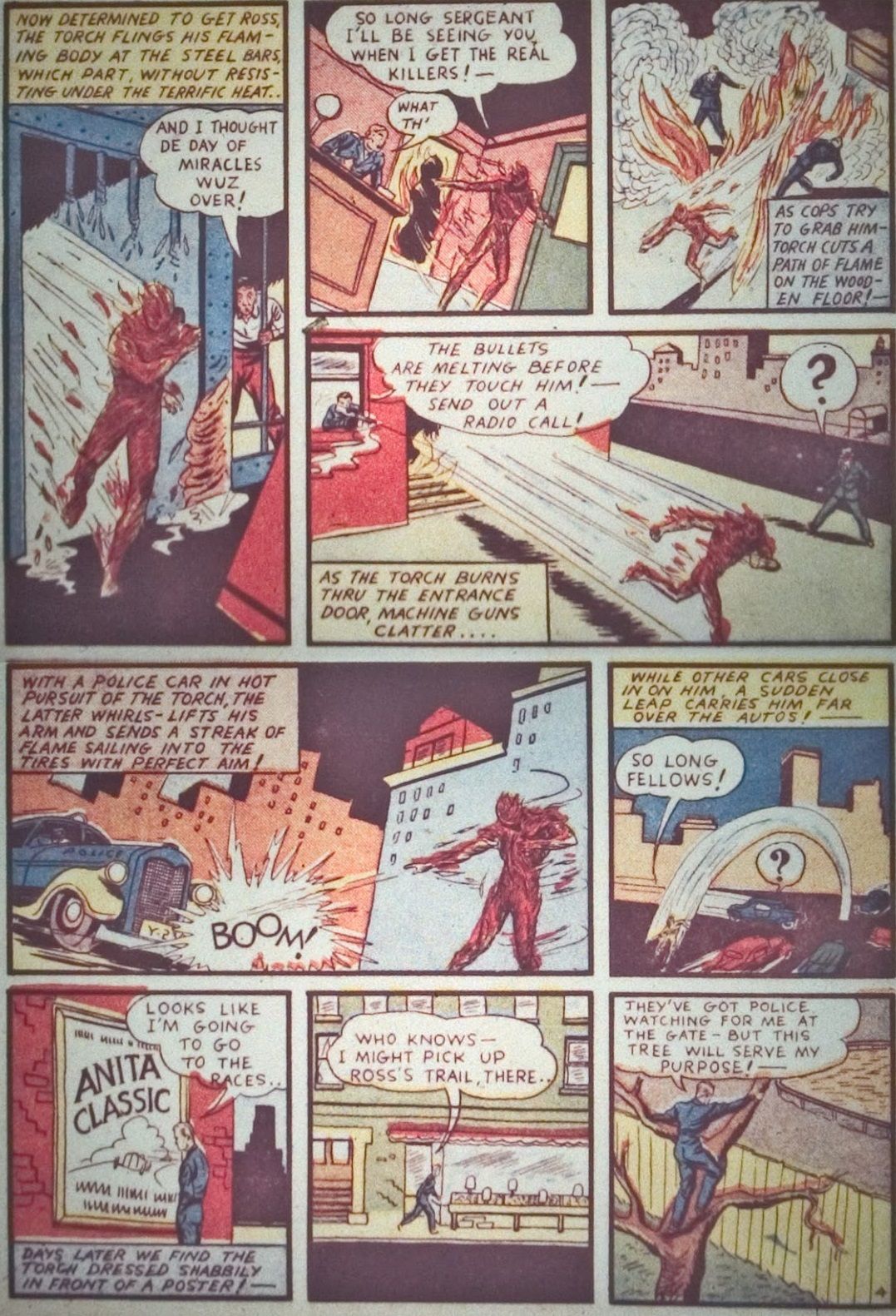
In his first appearance, the Torch did not blast anyone with flames, but he did so in his second appearance and that became a recurring deal for him (Will Eisner and Lou Fine had created The Flame earlier in 1939 for Fox Feature Syndicate's Wonderworld Comics #3, but he used a flame gun).
Another simple one! While a number of superheroes certainly HAD super speed by this point, like Superman, it clearly wasn't intended as their main superpower the way we think of when we think of speedster superheroes.
That changed with the Flash, created by Gardner Fox and artist Harry Lampert, in 1939's Flash Comics #1...

Like flying superheroes, speedster superheroes seemed to just be the next "thing," as a number of them popped up right after the Flash.
Comic books first leaned into patriotism in late 1939 when Harry Shorten and Irv Novick introduced the Shield in MLJ Comics' Pep Comics #1...
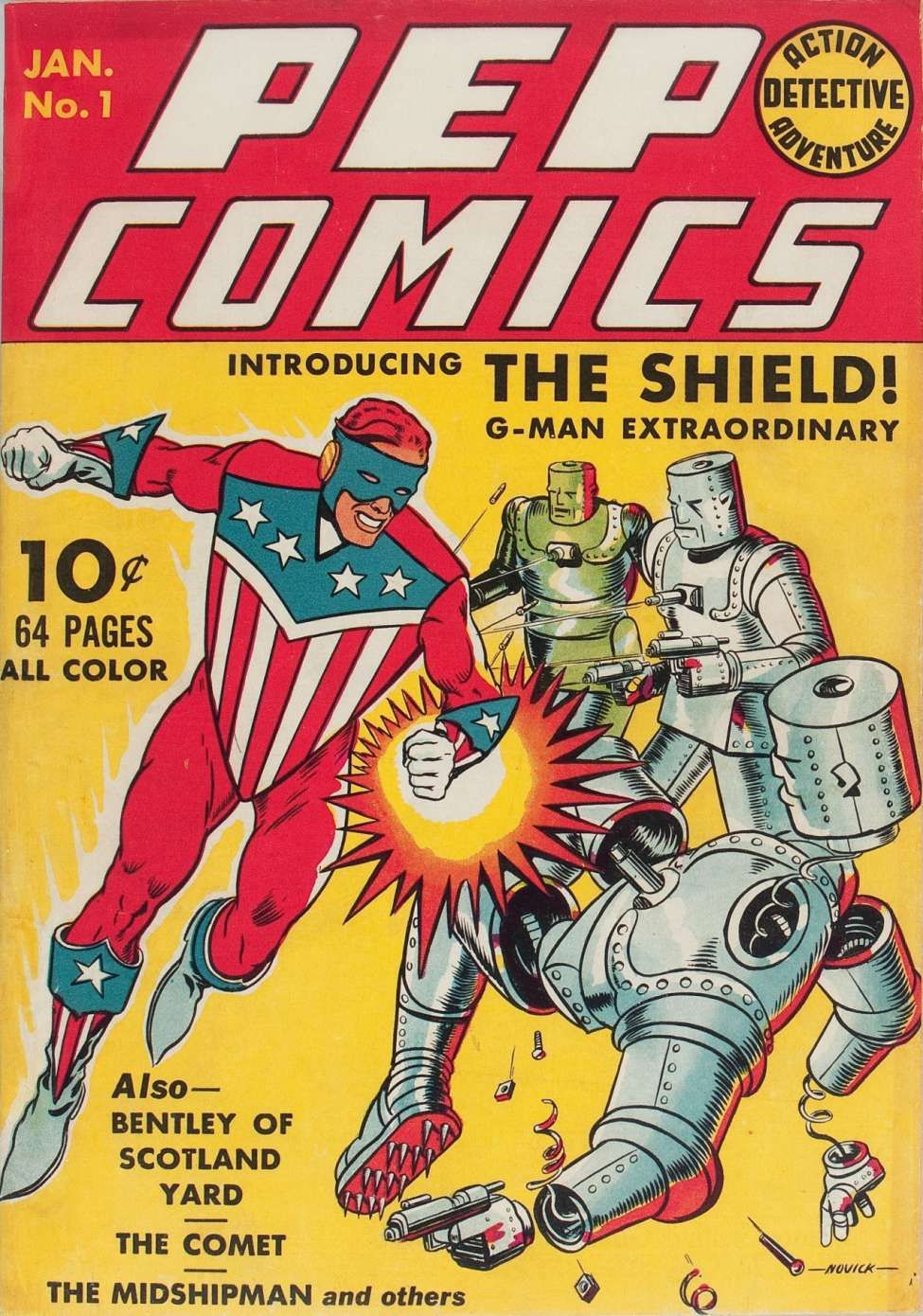
21 issues later, a certain redheaded teenager would debut as a backup feature in Pep Comics and soon took over the entire company!
As noted, there were so many magician superheroes that sometimes, they WOULD change their size through magic, but it was never their main deal. There was also a superhero named Minimidget who was shrunken down by a scientist, but he was stuck at that size.
So the first size-changing superhero where that was their main deal was Will Eisner's Doll-Man, in late 1939's Feature Comics #27 by Quality Comics (Quality, amusingly, had been founded on the assumption that the real money in comics was licensing the big name comic strips and that was what Feature Comics was, but when the superhero boom happened, they eventually got in on it, as well, using the great Will Eisner as their guide)...
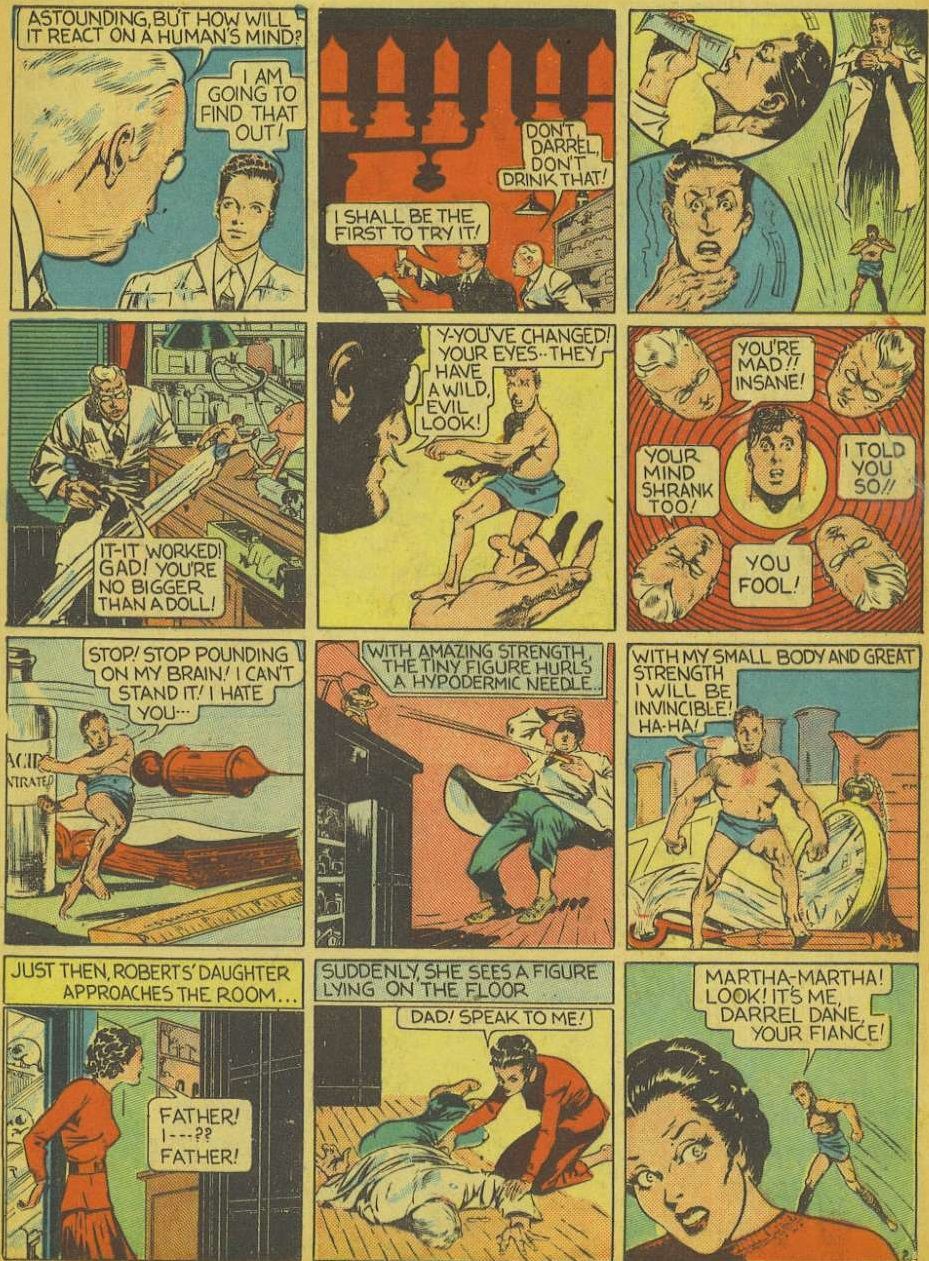
Once again, as noted, there were so many magician superheroes that there was the occasionally mind-reading involved, but not really all that frequently and never as the main deal. When Will Harr and Edd Ashe introduced The Wizard for MLJ Comics in 1939 in Top Notch Comics #1, he was a direct Mandrake the Magician ripoff, but he slowly got more distinct over time, as he used various ingenious inventions to fight crime. His hook was that he had a "Super-Brain."
However, by Top Notch Comics #4 in very early 1940, the "Super-Brain" idea had first evolved in Top Notch Comics #3 to an ability to see different scenarios so clearly that it was like he was actually viewing them to the point of him just having hypnosis and telepathy...
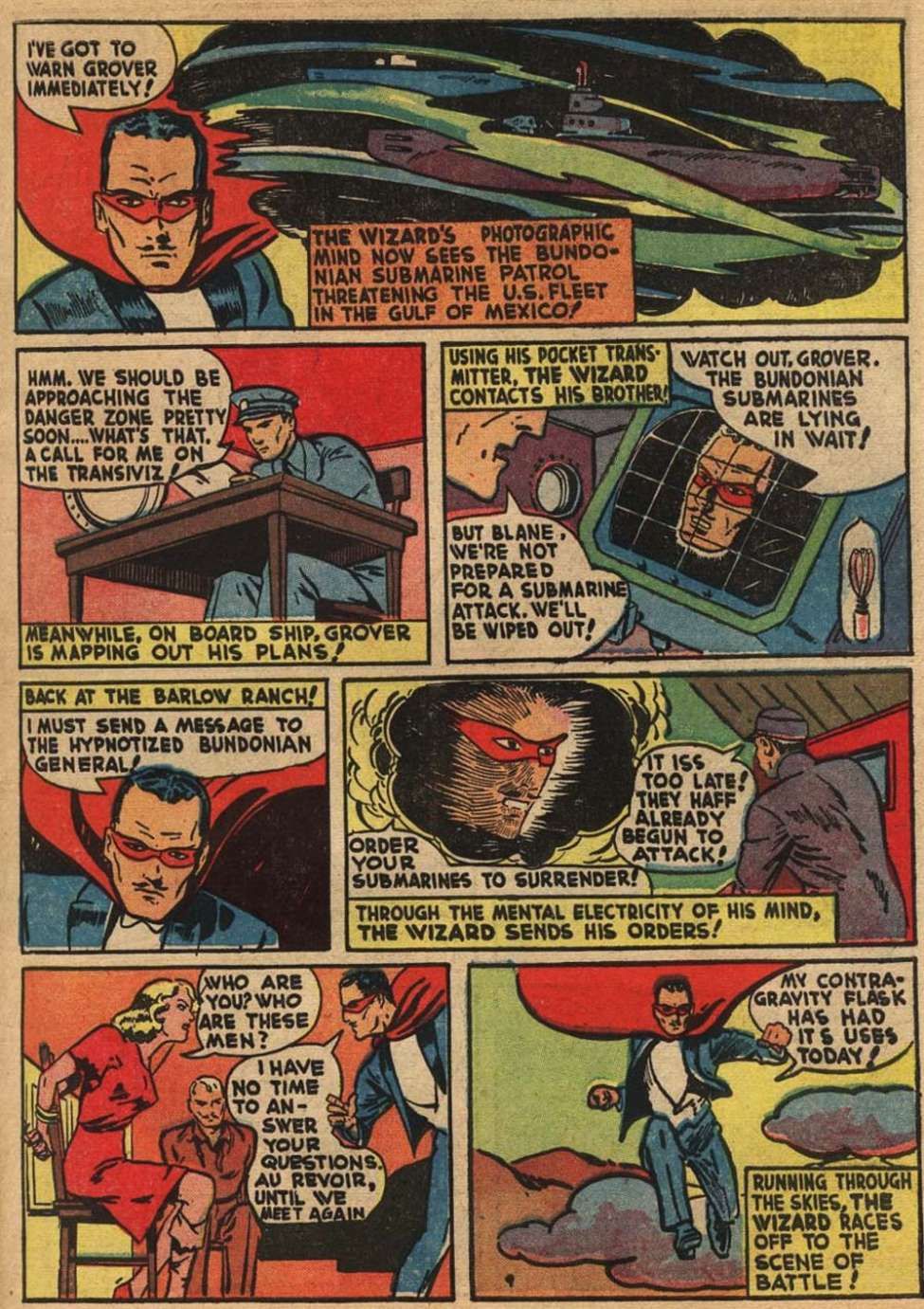
If anyone else has a suggestion for/question about a notable comic book first, drop me a line at brianc@cbr.com!
0 Comments